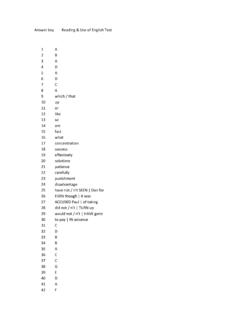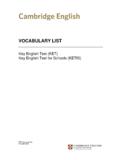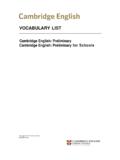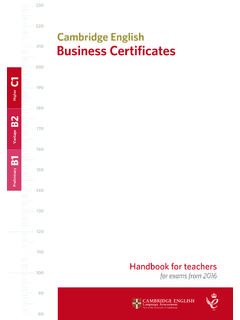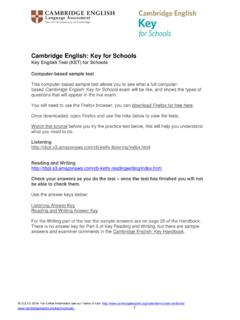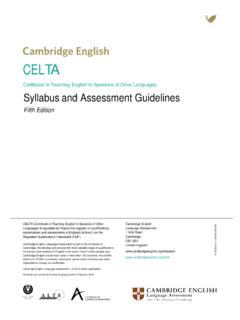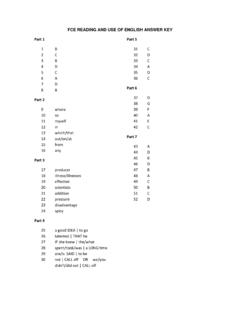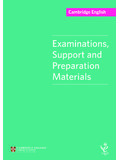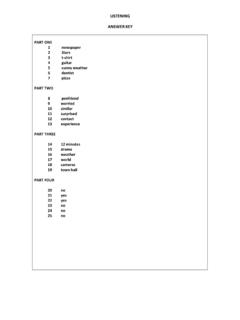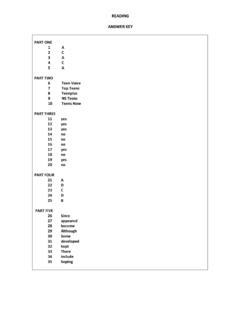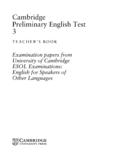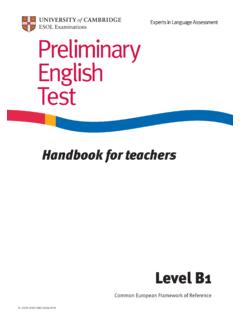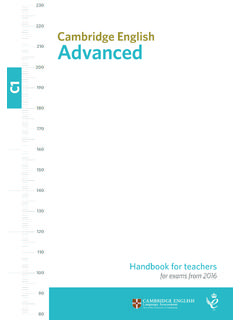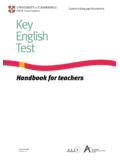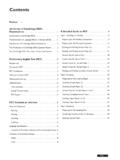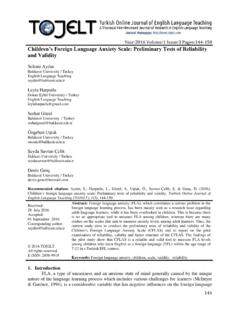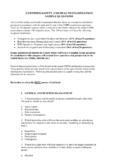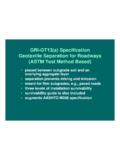Transcription of Assessing Writing Performance – Level B1
1 Assessing Writing Performance Level B1 Writing assessment by examiners in the Cambridge english : preliminary (PET), preliminary (PET) for Schools and Business preliminary exams (BEC) Cambridge english Writing scripts are marked by trained examiners in a secure online marking environment. The quality assurance of Writing Examiners (WEs) is managed by Team Leaders (TLs) who are in turn responsible to a Principal Examiner (PE). All of the examiners (PEs, TLs and WEs) must prove each year, through a certification process, that they are competent to assess. In addition, they are regularly monitored during live testing sessions. The Writing Examiners award marks using a Writing Assessment Scale which was developed with explicit reference to the Common European Framework of Reference for Languages (CEFR).
2 It covers all the levels of the Cambridge english exams and is divided into four subscales: Content This focuses on how well the candidate has fulfilled the task, in other words, if they have done what they were asked to do. Communicative Achievement This focuses on how appropriate the Writing is for the task, and whether the candidate has used the appropriate register. Organisation This focuses on the way the candidate puts together the piece of Writing , in other words, if it is logical and ordered. Language This focuses on vocabulary and grammar. It includes the range of language as well as how accurate it is. Examiners use the B1 Level Assessment Scales to decide which marks to give candidates taking the preliminary , preliminary for Schools and Business preliminary Writing test.
3 How can I use the Assessment Scales? Using the scales yourself while marking students Writing will help you to: analyse your students strengths and weaknesses when they practise B1 Writing tasks form an impression of how ready your students are to take the Writing part of the exam. UCLES 2014. Assessing Writing Performance Level B1. Published by Cambridge english Language Assessment. For further information see our Terms and Conditions. The Assessment Scales The B1 Assessment Scales are divided into six bands from 0 to 5, with 0 being the lowest and 5 the highest. Descriptors for each criterion are provided for bands 1, 3 and 5 and indicate what a candidate is expected to demonstrate at each band. The descriptors for band 3 and above generally indicate Performance of at least B1 Level .
4 B1 CONTENT COMMUNICATIVE ACHIEVEMENT ORGANISATION LANGUAGE 5 All content is relevant to the task. Target reader is fully informed. Uses the conventions of the communicative task to hold the target reader s attention and communicate straightforward ideas. Text is generally well-organised and coherent, using a variety of linking words and cohesive devices. Uses a range of everyday vocabulary appropriately, with occasional inappropriate use of less common lexis. Uses a range of simple and some complex grammatical forms with a good degree of control. Errors do not impede communication. 4 Performance shares features of Bands 3 and 5. 3 Minor irrelevances and/or omissions may be present. Target reader is on the whole informed. Uses the conventions of the communicative task in generally appropriate ways to communicate straightforward ideas.
5 Text is connected and coherent, using basic linking words and a limited number of cohesive devices. Uses everyday vocabulary generally appropriately, while occasionally overusing certain lexis. Uses simple grammatical forms with a good degree of control. While errors are noticeable, meaning can still be determined. 2 Performance shares features of Bands 1 and 3. 1 Irrelevances and misinterpretation of task may be present. Target reader is minimally informed. Produces text that communicates simple ideas in simple ways. Text is connected using basic, high-frequency linking words. Uses basic vocabulary reasonably appropriately. Uses simple grammatical forms with some degree of control. Errors may impede meaning at times. 0 Content is totally irrelevant.
6 Target reader is not informed. Performance below Band 1. As you look through the scales, it may help to highlight words which make one band different from another. For example, under the Language subscale, the descriptor at Band 1 (below B1 Level ) for grammar Uses simple grammatical forms with some degree of control is described in similar language to the Band 3 descriptor (B1 Level ), but with key differences. Uses simple grammatical forms with a good degree of control. So at B1 Level , simple forms are expected, used with a good degree of control. At Band 5 (B2 Level ), a writer Uses a range of simple and some complex grammatical forms with a good degree of control. UCLES 2014. Assessing Writing Performance Level B1.
7 Published by Cambridge english Language Assessment. For further information see our Terms and Conditions. Don t worry if a lot of the terms used in the scales are new to you in Appendix A (and also in the Handbooks for Teachers for each exam) you will find a Glossary of Terms for Writing , where the terminology used in the scales is explained, and examples are given. For example, under the Language subscale, there are examples of simple and complex grammatical forms and an explanation of what is meant by grammatical control and range. The Language subscale also includes vocabulary, and the difference between basic and everyday vocabulary and less common lexis is explained, as well as a description of appropriacy of vocabulary. Under the Organisation subscale, there are examples of linking words and cohesive devices, and an explanation of the difference between them.
8 It is well worth spending some time looking through the glossary of terms and becoming familiar with the terms used, as well as referring to them constantly when marking your students work, as the Cambridge english examiners do. How can I use the Assessment Scales with students? You could: 1. Refer to the scales as you mark students written work in general, especially when they have attempted a preliminary or Business preliminary Writing task. 2. Note down examples of Performance in terms of the listed criteria. 3. Give students feedback on their strengths and weaknesses. 4. Think about whether your students are ready for the exam and how they could improve. As teachers are not trained in the use of these Assessment Scales, as examiners are, it can be difficult to feel confident in using them in the right way.
9 The following activity is designed to help you get started by practising using them to analyse some sample Writing tasks. The activity is based on some sample scripts from preliminary , preliminary for Schools and Business preliminary Writing tasks: Sample script 1: preliminary for Schools Part 1 Sample script 2: preliminary for Schools Part 3 Sample script 3: preliminary Part 3 Question 8 Sample script 4: preliminary for Schools Part 3 Sample script 5: Business preliminary Part 2 The tasks for each of these scripts can be found in the Appendices, and further information on the task types and their focus can be found in the relevant Handbook for Teachers. UCLES 2014. Assessing Writing Performance Level B1. Published by Cambridge english Language Assessment.
10 For further information see our Terms and Conditions. Activity 1 Make a copy of the blank assessment sheet on pages 5/6. You will see that statements from the Assessment Scales have been turned into questions. 2 Read the preliminary for Schools Writing Part 1 task (see Appendix). 3 Read Sample Script 1. Note down your comments and examples of good and not so good elements of the candidate s Writing for each of the questions in the boxes on the assessment sheet. Make sure that while you are doing this you constantly refer to the B1 Assessment Scales and Glossary of Terms. 4 Compare the notes you have made with the completed example on page 7/8. 5 Repeat stages 1 4 for each of the other sample scripts, as appropriate. 6 When you feel familiar with using the Assessment Scales, continue to use the blank assessment sheet when Assessing your own students Writing and use this to give them feedback on what aspects of the scales they need to work on to improve.
